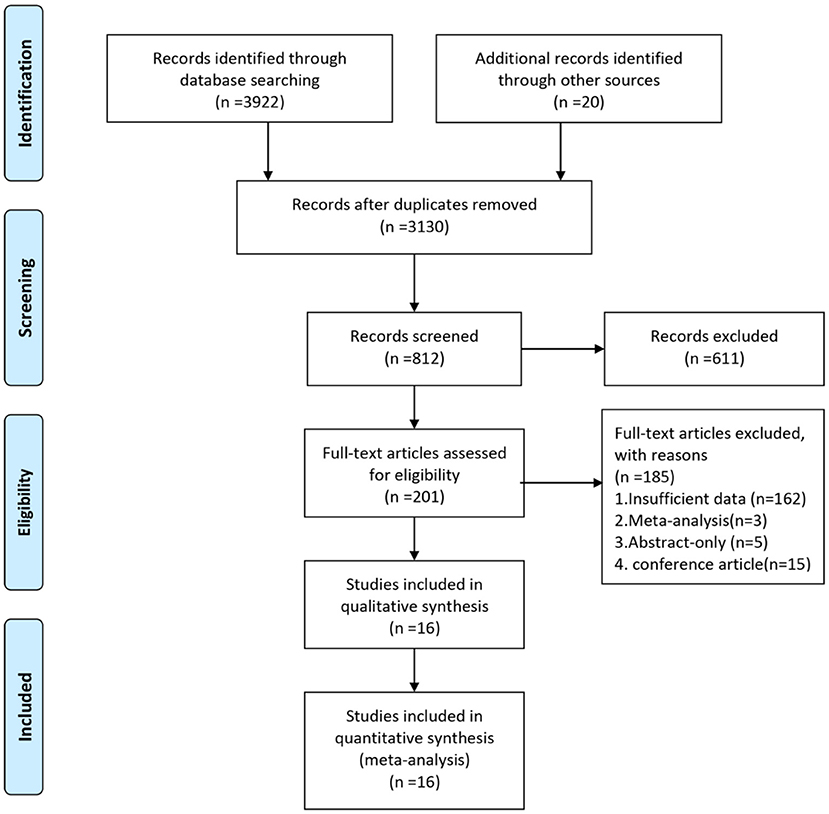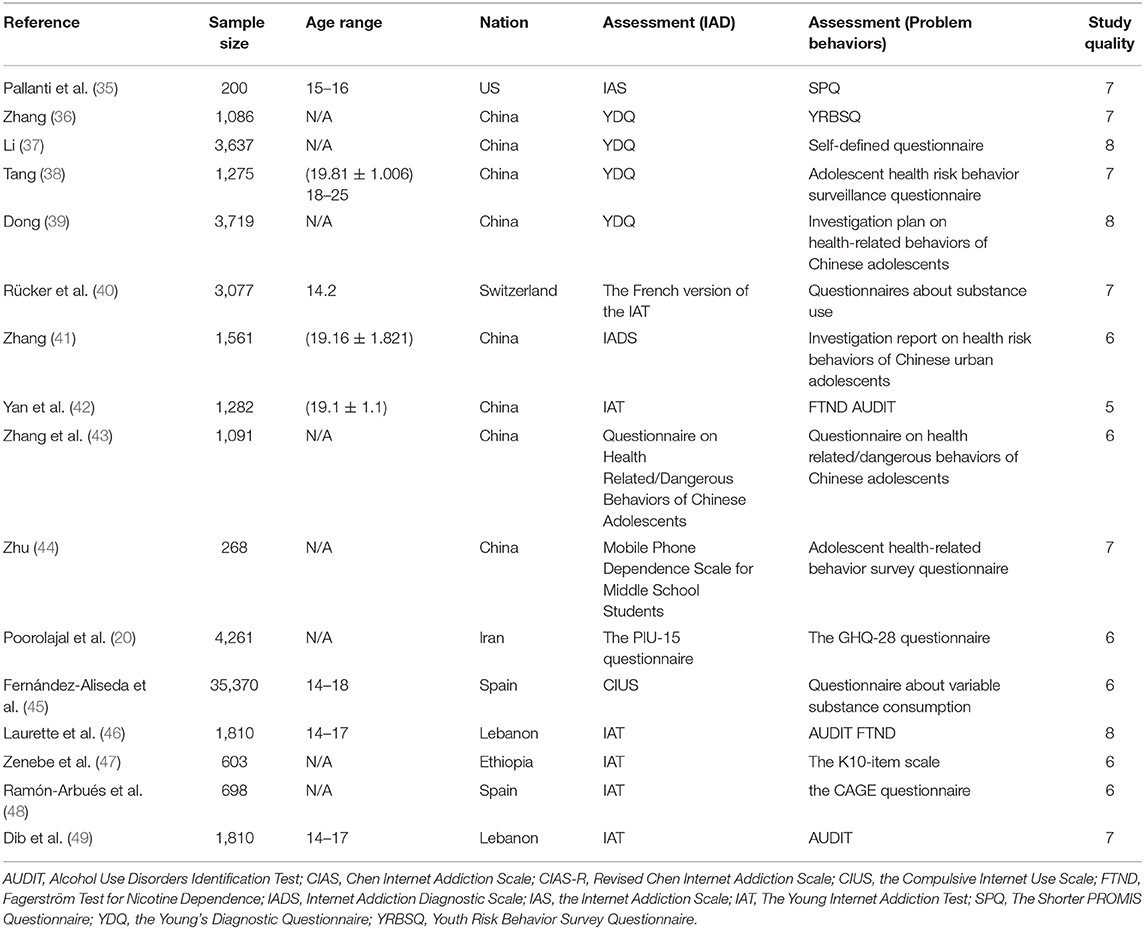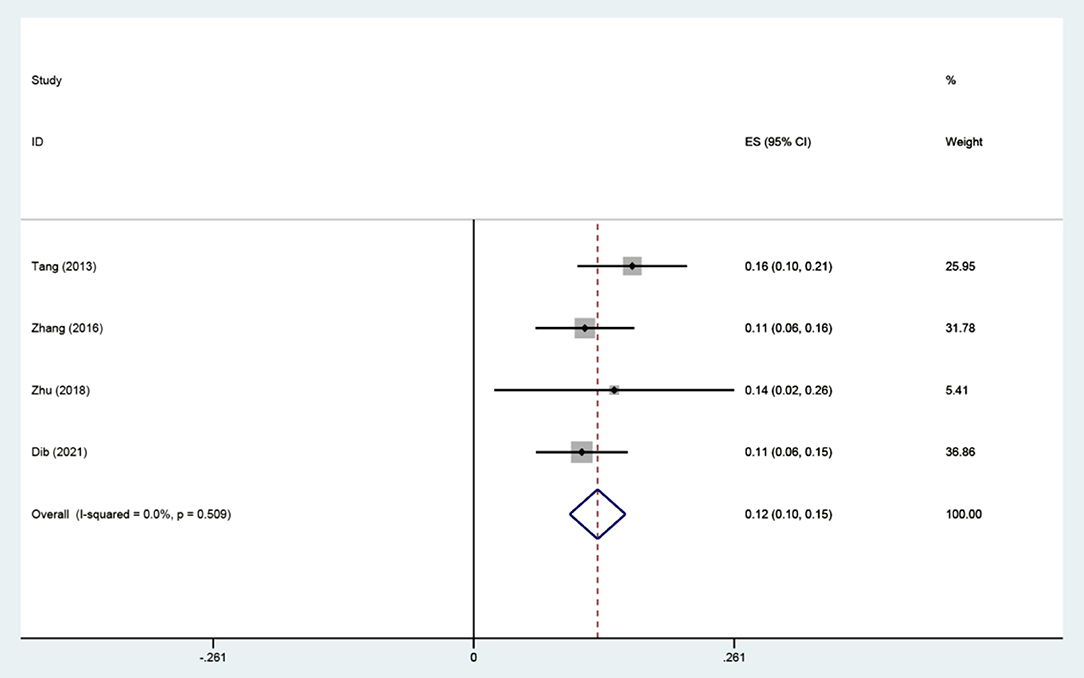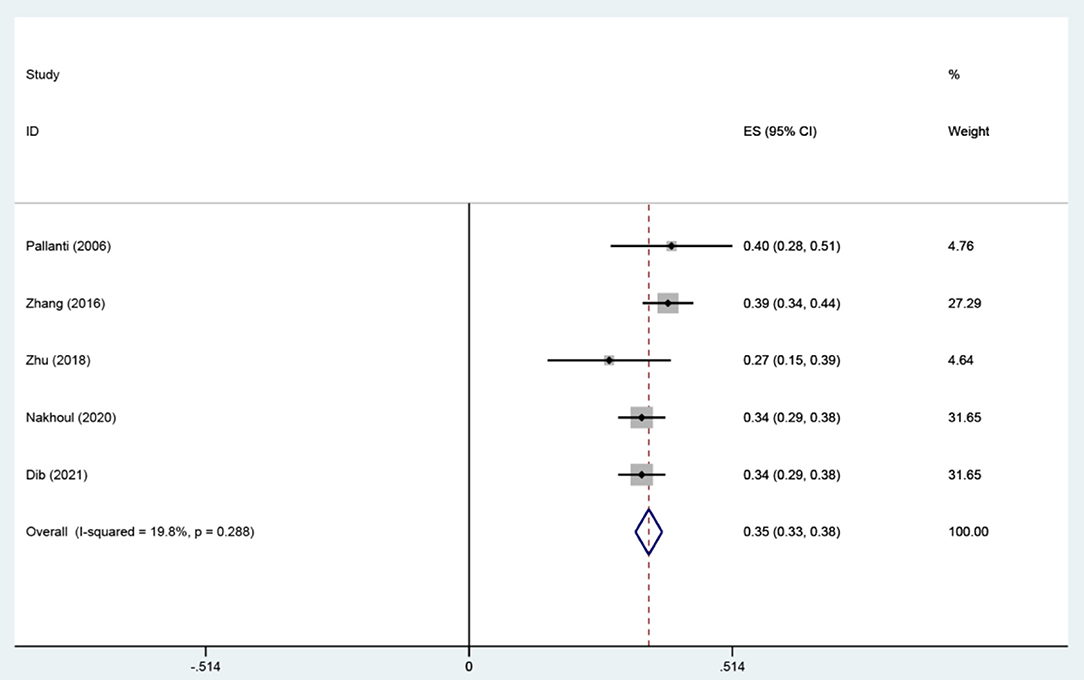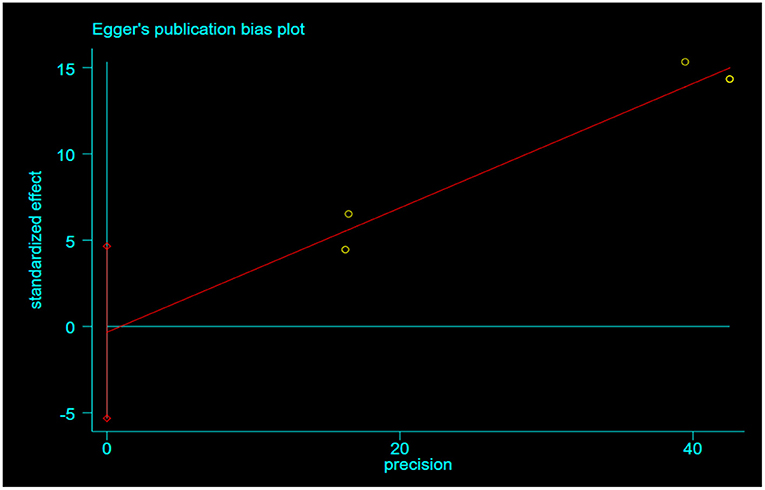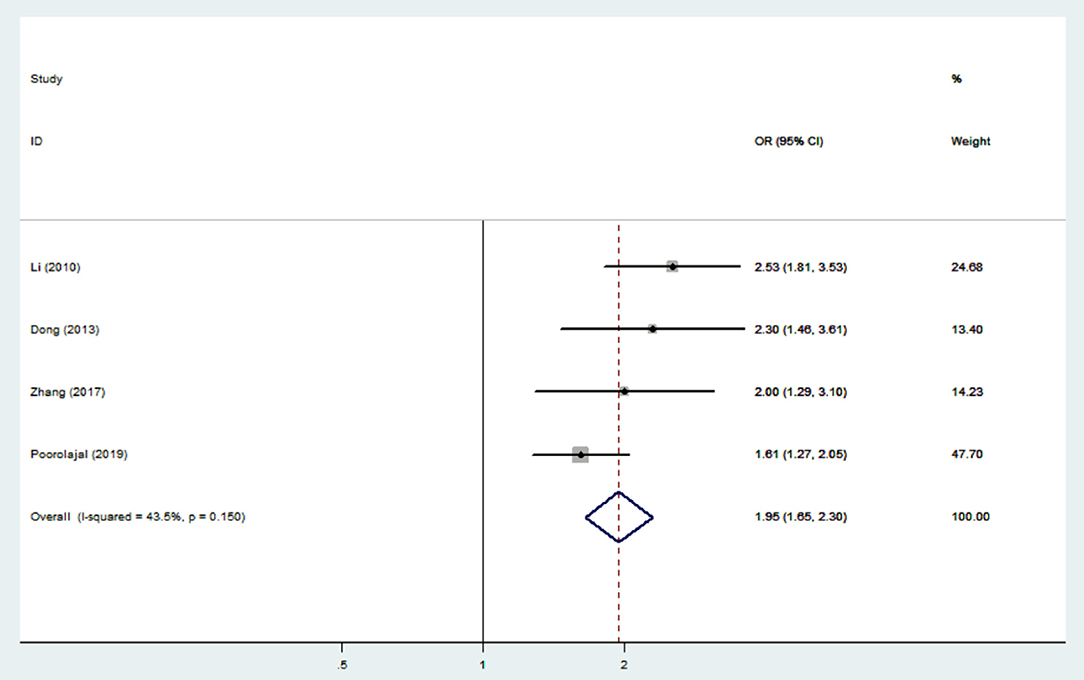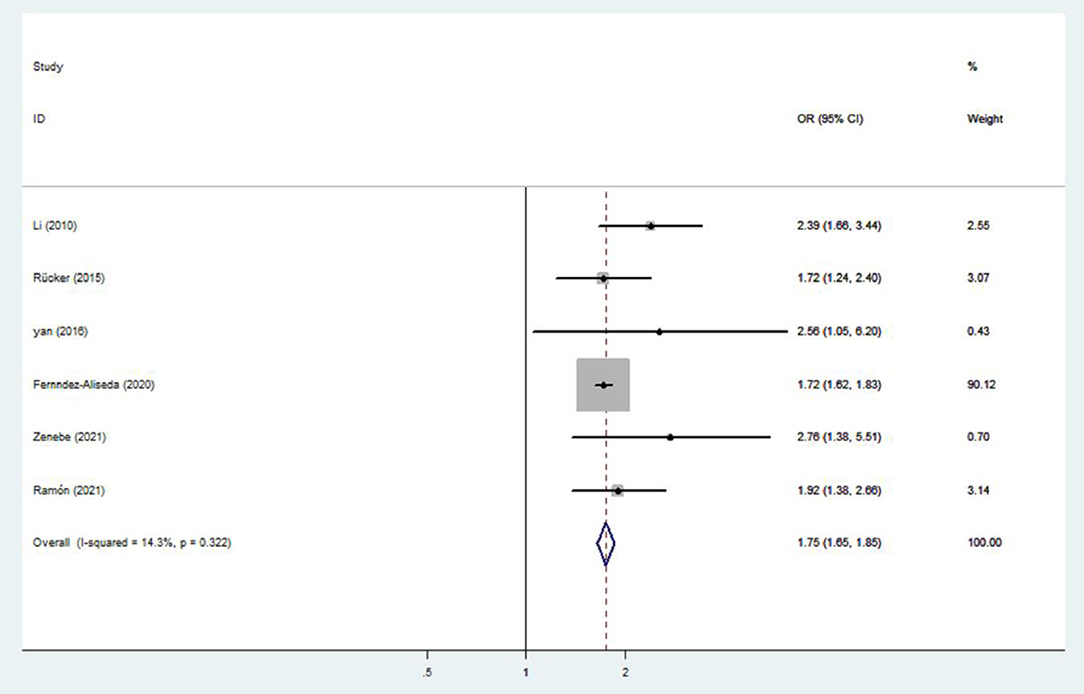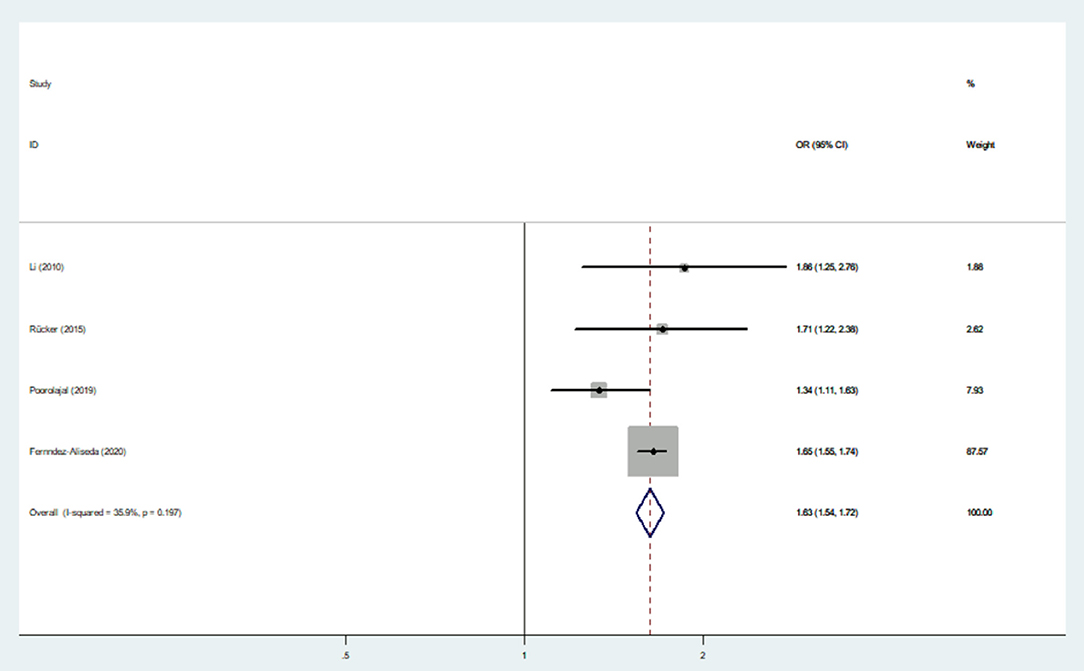- 1School of Rehabilitation and Health Preservation, Chengdu University of Traditional Chinese Medicine, Chengdu, China
- 2School of Acupuncture and Tuina, Chengdu University of Traditional Chinese Medicine, Chengdu, China
- 3School of Preclinical Medicine, Chengdu University, Chengdu, China
Background: Internet addiction disorder (IAD) is a global issue that has resulted in a slew of physical and emotional consequences. Studies have indicated that health risk behaviors might be the risk factors for IAD. The published literature on the correlation between the two is lacking. Therefore, we conducted a comprehensive analysis to understand better the link between IAD and health risk behaviors among adolescents and young adults.
Methods: We searched ten electronic databases for relevant articles. Data were extracted based on IAD and health risk behaviors ( alcohol, smoking, suicidal, gambling and drug abuse). We calculated odds ratios (ORs), a pooled correlation coefficient (r) and 95% confidence intervals (CIs). A fixed-effect model was applied to summarize the pooled effects. Heterogeneity was examined using I2 statistics and Cochran's Q statistics. All analyses were conducted by using Stata version 15.0.
Results: A total of 16 studies and 61,823 participants were included in this study. Meta-analysis showed that IAD was positively correlated with drinking (r = 0.35; 95% CI 0.32–0.37) and smoking (r = 0.12; 95%CI 0.10–0.15), and was associated with an increased risk of suicidal behavior (OR= 1.95; 95% CI 1.65–2.30), drinking (OR= 1.75; 95% CI 1.65–1.85), and smoking (OR= 1.63; 95% CI 1.54–1.72) among adolescents.
Conclusion: We found significantly increased risks of suicidal behavior, drinking, and smoking in adolescents and young adults with IAD. These findings are important to expand our understanding of IAD and have great guiding significance for preventing health risk behaviors of adolescents and young adults.
Systematic Review Registration: https://www.crd.york.ac.uk/prospero/display_record.php?ID=CRD42021257729, identifier: PROSPERO CRD42021257729.
Introduction
Internet addiction disorder (IAD) is considered as an inability of individuals to control their internet use, resulting in marked distress and functional impairment in daily life such as psychological, social, academic, and professional problems (1). The overall prevalence of IAD ranges from 1.5 to 8.2% in the United States and Europe (2). IAD has attached much attention throughout the world among adolescents, with a prevalence of 7.9–16.0% (3–5).
To date, the diagnostic criteria, and classification of IAD are still controversial, and its assessment instruments are inconsistent due to sociocultural and socioeconomic factors. Some scholars have argued that using traditional addiction criteria to define the boundaries of the IAD does not highlight the uniqueness of the behavior itself (6, 7). It has been suggested that IAD is not a mental disorder or addiction, but rather a problematic behavior (8, 9). To date, its causative theories and clinical features are still under investigation and being constantly updated.
Notably, internet gaming disorder (IGD) is an important subtype of IAD (10). IGD as a proposed behavioral addiction included in Section III of DSM-5 (11) and adopted at the World Health Assembly as a diagnosis in ICD-11 (12). The number of adolescents with IGD who suffer withdrawal and tolerance symptoms and lose interest in other activities is increasing dramatically and has now been recognized as a common behavioral problem worldwide (13).
Risky behavioral lifestyles, such drinking, smoking, suicidal behavior, gambling and drug abuse are closely related to the healthy development of adolescents and young adults. Previous research reported a positive association between IAD and adolescents Risky behavioral lifestyles, such drinking, smoking, suicidal behavior, gambling and drug abuse are closely related to the healthy development of adolescents and young adult's risk behaviors (14, 15). Gansner et al. (16) and Berardelli et al. (17) found that the level of internet dependence was associated with a higher suicidal behavior risk. Kim et al. (18) and Na et al. (19) showed that the time spent playing internet games is closely related to the degree of alcohol consumption, but Poorolajal et al. (20) found no significant correlation between the two. Some studies have suggested that smokers might more easily develop IAD (21, 22). Furthermore, a study on 467 Chinese adolescents demonstrated that individuals with IAD or IGD might engage in more risky behaviors (skipping school, smoking, drinking, fighting, gambling, stealing) (23).
Taken together, the data from this series of studies have been useful in demonstrating that IAD is associated with health risk behaviors. However, due to the limitations of the sample sizes and regional effects in many studies, their results were different to some extent. Thus, it is necessary to evaluate the relationship between IAD and health risk behaviors. The findings will lay the foundation for studying the characteristics of IAD among adolescents and young adults and its associated correlates. The results may provide evidence to support the development of more effective interventions.
Materials and Methods
This systematic review and meta-analysis were conducted following the Preferred Reporting Items for Systematic Review and Meta-Analyses (PRISMA) (24, 25) guidelines. The review protocol was registered in PROSPERO (CRD42021257729) URL: https://www.crd.york.ac.uk/prospero/#recordDetails.
Search Strategies
We searched ten international electronic databases including PubMed, Embase, Web of Science (WOS), the Cochrane Library, PsycINFO, ERIC, China National Knowledge Infrastructure (CNKI), Chinese Biomedical Literature Database (CBM), Technology Periodical Database (VIP) and Wan Fang Database. We also performed a manual search of the gray literature listed in the bibliography, including dissertations and conference papers. This search was updated on Aug 2021. The detailed search strategy for PubMed is provided in Supplementary Material 1, and other databases are modified as necessary.
Eligibility Criteria
Study Design
Studies were included if they fulfilled the following criteria: (1) used a validated scale to assess IAD; (2) reported the relationship between IAD and health risk behaviors; (3) were observational studies published up to Aug 2021; (4) had a Pearson or Spearman correlation coefficient (r) or odds ratios (ORs) available; (5) were published in Chinese or English.
Case reports, meeting abstracts, review papers, commentaries, and those with inadequate information were excluded.
Participants
Participants were adolescents and young adults aged between 12 and 25 with a standard diagnosis of IAD and associated health risk behaviors. There were no restrictions on gender or race.
Exposures
Studies needed to have clearly reported smoking, drinking, suicidal behavior and other health risk behaviors. For the purposes of this review, health risk behaviors were defined as related behaviors reported at least once in the previous 30 days. That is, a study presenting results in terms of a range of frequencies (“often” and “frequently”) would be chosen for inclusion.
Interventions and Comparisons
Since this meta-analysis was based on published articles to investigate the relationship between IAD and health risk behaviors, there were no comparison or intervention groups.
Outcome Measures
Studies must have included IAD as an independent variable and health risk behaviors as dependent variables for identified associations. Studies that did not adjust for these variables in the outcome analysis were included in this study. Health risk behaviors were measured by the related scales or self-report questionnaires. IAD was measured by Young Diagnostic Questionnaire for IAD (YDQ) (26), Chinese Internet Addiction Scale Revision (CIAS-R) (27), Internet Addiction Test (IAT) (28) and other relatively high-quality scales/questionnaires designed to measure IAD.
Data Extraction
Two reviewers independently (JW and QH) completed the title, abstract and full text screening. Items were extracted from the eligible studies including: first author, publication year, country, sample size, age, gender, measures of IAD and health risk behaviors, Pearson or Spearman correlation coefficient (r) or ORs between IAD and health risk behaviors. Disagreements were settled by consensus and discussion with a third reviewer (YT).
Quality Assessment
The Agency for Healthcare Research and Quality (AHRQ), which contains 11 items, was used to evaluate the quality of the cross-sectional studies. The answer “yes” scored 1, while “no” or “unclear” scored 0. Scores of 8–11 were classified as high-quality research, and scores of 4–7 were classified as moderate quality (29).
Data Synthesis and Analysis
The relationship between IAD and health risk behaviors was assessed using the Pearson correlation coefficient (r- value). “Fisher's z transformation” was used to convert Spearman's correlation coefficients into the normal distribution. The formula for the transformation is z = 0.5[ln(1+r)−ln(1−r)] where “ln” is the natural logarithm (30). In addition, the included studies were weighted according to the magnitude of the respective standard error (SE). The formula for the transformation is SE = where “N” represents the respective sample size (30). The degree of variation was estimated by the standard error (SE) and 95% confidence intervals (CIs). The r < 0.21 indicated poor correlation; 0.21 ≤ r < 0.41 was considered average correlation; 0.41 ≤ r < 0.61 suggested moderate correlation; 0.61 ≤ r < 0.81 meant significant correlation and > 0.81 suggested strong correlation (31). For meta-analyses of ORs, we used the logarithm as the effect size (32). Final results were transformed from the log of the ORs to the ORs for presentation. Heterogeneity was determined using I2 statistics and Cochran's Q statistics. A fixed-effects model was employed to analyze the data if I2 ≤ 50% and the P-value for the Q-statistic > 0.05. Otherwise, a random-effects model was applied (33). If notable heterogeneity was found, a sensitivity analysis was performed and we examined the stability of the pooled estimate for each study by excluding individual studies one by one from the analysis. Publication bias was examined by Egger's tests and funnel plots (34). The statistical significance was set at P < 0.05.
All of the above data processing was conducted with STATA Version 15.0 Statistical Software.
Results
Selected Studies
A total of 3,942 records were identified, and 3,130 records were left after removing duplicates. Finally, 201 records were needed for full-text assessments after reviewing the titles and abstracts. After reading the full-text articles, 16 studies were selected for inclusion in this systematic review. The study selection process is displayed in Figure 1.
Study Design Characteristics
Table 1 shows the characteristics of the 16 included studies. All included studies were cross-sectional studies. A total of 61,823 participants were included in this review. The included studies were conducted in more than seven different countries around the world, including the US (n = 1), Switzerland (n = 1), Iran and several other middle eastern countries (n = 1), Ethiopia (n = 1), Lebanon (n = 2), Spain (n = 2), and China (n = 8). Although several studies did not specify the age range of the participants, they mentioned the educational stage of the participants, and the majority of them were university students. IAT is the most commonly used diagnostic tool for IAD, followed by YDQ. Regarding the measures of health risk behaviors, most of them were questionnaires/scales drawn up based on the cultural background of the country.
Quality of the Studies
All included studies scored above four points, ranging from 5 to 7 (Table 1).
Meta-Analysis
The Association Between IAD and Health Risk Behaviors According to Pearson Correlation
Seven studies were included to assess the relationship between IAD and smoking (36, 38, 41, 44, 49), drinking (35, 41, 44, 46, 49). There were positive associations between IAD and drinking, and smoking. A fixed-effects model was used to calculate the effect size of IAD and drinking (I2= 19.8%, P = 0.288). The combined correlation coefficient(r) was (r = 0.35; 95% CI 0.32, 0.37) (Figure 2). The combined effect size of IAD and smoking was (r = 0.14; 95% CI 0.10, 0.18) with slight heterogeneity (I2= 55.6%, P= 0.061). We conducted sensitivity analyses to identify the source of the heterogeneity. The result indicated that heterogeneity was significantly reduced when we removed the study by Zhang (36). We found that Zhang's study investigated the students whose former-drinkers accounted for the largest proportion, while the others focused on current drinking. We recalculated the effect size based on the fixed-effects model after excluding this study (r = 0.12; 95% CI 0.10, 0.15) and the heterogeneity disappeared (I2 = 0.00%, P = 0.509) (Figure 3). No apparent publication bias was observed according to Egger's test (P = 0.844) (Figure 4).
The Association Between IAD and Health Risk Behaviors According to Logistic Regression
Nine studies were used to evaluate the association between IAD and smoking (20, 37, 40, 45), suicidal behavior (20, 37, 39, 43) and drinking (37, 40, 42, 45, 47, 48). The heterogeneity was not significant (I2 < 50%), and a fixed-effects model was applied. The sizes of the pooled effect of IAD on suicidal behavior, drinking and smoking were (OR = 1.95; 95% CI 1.65–2.30) (Figure 5), (OR= 1.75; 95% CI 1.65–1.85) (Figure 6) and (OR = 1.63; 95% CI 1.54–1.72) (Figure 7), respectively.
Discussion
Our meta-analyses showed that IAD was positively associated with smoking and drinking. We found that IAD was significantly associated with an increased risk of suicidal behavior, drinking and smoking.
The present review found that adolescents and young adults with IAD have a significantly higher risk of suicidal behavior than others, in line with the literature (50–52). A total of 4 studies with 12,708 participants were included. All of the participants were students, and one study only investigated all ethnic minority students living in rural areas, which limited the generalizability of the findings (43). In addition, all included studies highlighted mood disorders, the broadest contributing factor to suicidal ideation in adolescents, consistent with previous studies (53). Adolescents and young adults have more negative self-cognition and are prone to mood disorders when facing pressure (20, 37, 39, 54, 55), and rural students who lack family care, supervision, and opportunities to share their distress, are more likely to have negative emotions and suicidal ideation (43).
The internet is a virtual space with identity concealing that can provide an online sharing community, coupled with the poor self-control of adolescents and young adults, which makes them more likely to develop IAD (20, 37, 39, 56). At the same time, long-term exposure to such negative information increases the risk of suicidal behavior (57). In conclusion, it is of great significance to pay attention to the emotional state of adolescents and carry out necessary interventions for the prevention of IAD and suicidal behavior.
There were 13 studies with 55,927 participants included that evaluated the relationship between IAD and drinking and smoking. The results suggested that there was a average positive correlation between IAD and drinking, and a poor positive correlation with smoking. Analysis based on ORs showed that IAD was significantly associated with an increased risk of drinking and smoking.
Considering the differences in sociocultural and economic background among populations, there is no standard recognized assessment tool for health risk behavior assessment at present, and many studies are based on self-report questionnaires prepared by researchers . Some studies included data on engaging in at least once health risk behaviors in the past 30 days (20, 38, 40, 41, 45, 48), some included data on the use of relevant questionnaires to assess health risk behaviors (35, 42, 44, 46, 47, 49), and others only included data on often or frequent occurrences of health-risk behaviors (37), which reduced the accuracy of the results. The assessment tools for health risk behaviors should be more standardized in the future.
Additionally, scholars have found that smoking and drinking usually cluster since they may serve the same purpose socially and psychologically (58, 59). Researchers also noted that adolescent and young adults use of multiple different substances is associated with sensation seeking, risk-taking and increased experimentation (58, 60, 61), which are also among the motivations for playing online games (62, 63). Moreover, as previous research has demonstrated, internet activity, gaming cues, nicotine and alcohol all alter the brain's neural networks, activating brain regions involved in reward and motivational processing, such as the striatum, insula, and anterior cingulate cortex, resulting in abnormal metabolism of dopamine, which affects the function of the reward system (22, 64–66). This may also explain to a certain extent the increased risk of smoking and alcohol consumption in participants with IAD or IGD.
IAD has become an important global mental health issue, and is closely associated with an increased risk of drinking and smoking. Suicidal behavior is a risky behavior that interacts with and influences IAD. Adolescence, is at a stage when individuals are easily influenced by various complex and tempting social environments, forming a series of health risk behaviors (67). Therefore, prevention and education programs are urgently needed. Schools, teachers, and parents should pay more attention to the mental and emotional health of students and provide more timely practice guidance. In addition, governments should provide safety-net mental health services to adolescents and young adults when needed.
The limitations of this review were as follows: first, there were significant differences among reports on health risk behaviors due to the huge sociocultural context among different racial/ethnic groups that had implications for the current review. Second, suicidal behaviors includes suicidal ideation, suicide planning and suicide attempts. Since suicidal ideation is a strong risk factor for suicidal behaviors (68), we extracted data related to suicidal ideation. Finally, previous research showed that drinking and smoking were higher among boys, while girls had higher rates of suicidal behavior (69–71). Unfortunately, the data extracted in this study did not allow any gender associations to be analyzed. In addition, we also searched for articles about the relationship between IAD and drug misuse and gambling, but most existing literature only concerns online gambling and specific drug abuse.
Conclusion
Adolescents and young adults with IAD are at higher risk for suicidal behavior, drinking and smoking. Mood disorders are important mediators between IAD and suicidal behavior, and may be a target for effective intervention. In addition, it is important to explore the neural mechanisms of IAD/IGD and smoking, drinking and other substance dependence for the prevention and intervention of those problematic behaviors. The findings of this review are important for educational and psychological practitioners, parents and schools, and may provide guidance for the prevention and intervention of IAD and health risk behaviors.
Data Availability Statement
The original contributions presented in the study are included in the article/Supplementary Material, further inquiries can be directed to the corresponding authors.
Author Contributions
JW and QH conceived the idea. JW drafted the manuscript. YT, WP, and HL were involved in the interpretation of the study findings. TZ and YW reviewed the manuscript and provided comments. All authors contributed to the article and approved the submitted version.
Funding
This research was funded by the Natural Science Foundation of China (81072852 and 81574047), the Key R&D Project of Sichuan Province (2019YFS0175), the Xinglin Scholar Research Promotion Project of Chengdu University of TCM (XSGG2019007), and the Training Funds of Academic and Technical Leader in Sichuan Province.
Conflict of Interest
The authors declare that the research was conducted in the absence of any commercial or financial relationships that could be construed as a potential conflict of interest.
Publisher's Note
All claims expressed in this article are solely those of the authors and do not necessarily represent those of their affiliated organizations, or those of the publisher, the editors and the reviewers. Any product that may be evaluated in this article, or claim that may be made by its manufacturer, is not guaranteed or endorsed by the publisher.
Supplementary Material
The Supplementary Material for this article can be found online at: https://www.frontiersin.org/articles/10.3389/fpubh.2022.809232/full#supplementary-material
References
1. Vargas T, Maloney J, Gupta T, Damme KSF, Kelley NJ, Mittal VA. Measuring facets of reward sensitivity, inhibition, and impulse control in individuals with problematic Internet use. Psychiatry Res. (2019) 275:351–8. doi: 10.1016/j.psychres.2019.03.032
2. Egorov AY, Grechanyi SV. Current approaches to the treatment and correction of internet addiction. Zh Nevrol Psikhiatr Im S S Korsakova. (2019) 119:152–9. doi: 10.17116/jnevro2019119061152
3. Christakis DA. Internet addiction: a 21st century epidemic? BMC Med. (2010) 8:61. doi: 10.1186/1741-7015-8-61
4. Mihara S, Osaki Y, Nakayama H, Sakuma H, Ikeda M, Itani O, et al. Internet use and problematic Internet use among adolescents in Japan: a nationwide representative survey. Addict Behav Rep. (2016) 4:58–64. doi: 10.1016/j.abrep.2016.10.001
5. Vigna-Taglianti F, Brambilla R, Priotto B, Angelino R, Cuomo G, Diecidue R. Problematic internet use among high school students: prevalence, associated factors and gender differences. Psychiatry Res. (2017) 257:163–71. doi: 10.1016/j.psychres.2017.07.039
6. Kardefelt-Winther D. Conceptualizing Internet use disorders: addiction or coping process? Psychiatry Clin Neurosci. (2017) 71:459–66. doi: 10.1111/pcn.12413
7. King DL, Delfabbro PH. Is preoccupation an oversimplification? a call to examine cognitive factors underlying internet gaming disorder. Addiction. (2014) 109:1566–7. doi: 10.1111/add.12547
8. World Health Organization. Gaming Disorder. (2019). Available online at: https://icd.who.int/browse11/l-m/en#/http://id.who.int/icd/entity/1448597234.
9. Griffiths MD, Kuss DJ, Billieux J, Pontes HM. The evolution of internet addiction: a global perspective. Addict Behav. (2016) 53:193–5. doi: 10.1016/j.addbeh.2015.11.001
10. Griffiths MD, van Rooij AJ, Kardefelt-Winther D, Starcevic V, Király O, Pallesen S, et al. Working towards an international consensus on criteria for assessing internet gaming disorder: a critical commentary on Petry et al. (2014). Addiction. (2016) 111:167–75. doi: 10.1111/add.13057
11. Petry N, O'Brien C. Internet gaming disorder in the DSM-5. Addiction. (2013) 108:1186–7. doi: 10.1111/add.12162
12. van den Brink W. ICD-11 gaming disorder: needed and just in time or dangerous and much too early? J Behav Addict. (2017) 6:290–2. doi: 10.1556/2006.6.2017.040
13. Zajac K, Ginley MK, Chang R. Treatments of internet gaming disorder: a systematic review of the evidence. Expert Rev Neurother. (2020) 20:85–93. doi: 10.1080/14737175.2020.1671824
14. Holtz P, Appel M. Internet use and video gaming predict problem behavior in early adolescence. J Adolesc. (2010) 34:49–58. doi: 10.1016/j.adolescence.2010.02.004
15. Kim J, Lau CH, Cheuk K-K, Kan P, Hui H, Griffiths S. Brief report: predictors of heavy internet use and associations with health-promoting and health risk behaviors among Hong Kong university students. J Adolesc. (2009) 33:215–20. doi: 10.1016/j.adolescence.2009.03.012
16. Gansner M, Belfort E, Cook B, Leahy C, Colon-Perez A, Mirda D, et al. Problematic internet use and associated high-risk behavior in an adolescent clinical sample: results from a survey of psychiatrically hospitalized youth. Cyberpsychol Behav Soc Netw. (2019) 22:349–54. doi: 10.1089/cyber.2018.0329
17. Berardelli I, Corigliano V, Hawkins M, Comparelli A, Erbuto D, Pompili M. Lifestyle interventions and prevention of suicide. Front Psychiatry. (2018) 9:567. doi: 10.3389/fpsyt.2018.00567
18. Kim YJ, Kim DJ, Lee Y. The impact of internet gaming on alcohol consumption. J Ment Health Policy Econ. (2019) 22:61–70.
19. Na E, Lee H, Choi I, Kim DJ. Comorbidity of internet gaming disorder and alcohol use disorder: a focus on clinical characteristics and gaming patterns. Am J Addict. (2017) 26:326–34. doi: 10.1111/ajad.12528
20. Poorolajal J, Ahmadpoor J, Mohammadi Y, Soltanian AR, Asghari SZ, Mazloumi E. Prevalence of problematic internet use disorder and associated risk factors and complications among Iranian university students: a national survey. Health Promot Perspect. (2019) 9:207–13. doi: 10.15171/hpp.2019.29
21. Qiu X, Han X, Wang Y, Ding W, Sun Y, Zhou Y, et al. Interaction between smoking and internet gaming disorder on spontaneous brain activity. Front Psychiatry. (2020) 11:586114. doi: 10.3389/fpsyt.2020.586114
22. Ko CH, Liu GC, Yen JY, Yen CF, Chen CS, Lin WC. The brain activations for both cue-induced gaming urge and smoking craving among subjects comorbid with internet gaming addiction and nicotine dependence. J Psychiatr Res. (2013) 47:486–93. doi: 10.1016/j.jpsychires.2012.11.008
23. Jiang Q, Huang X, Tao R. Examining factors influencing internet addiction and adolescent risk behaviors among excessive internet users. Health Commun. (2018) 33:1434–44. doi: 10.1080/10410236.2017.1358241
24. Moher D, Shamseer L, Clarke M, Ghersi D, Liberati A, Petticrew M. Preferred reporting items for systematic review and meta-analysis protocols (PRISMA-P) 2015 statement. Syst Rev. (2015) 4:1. doi: 10.1186/2046-4053-4-1
25. Shamseer L, Moher D, Clarke M, Ghersi D, Liberati A, Petticrew M, et al. Preferred reporting items for systematic review and meta-analysis protocols (PRISMA-P) 2015: elaboration and explanation. BMJ. (2015) 350:g7647. doi: 10.1136/bmj.g7647
26. Yang W, Zhou Z. The relationship between the type of internet addiction and the personality trait in college students. J Huazhong Univ Sci Technol. (2004) 39–42. doi: 10.19648/j.cnki.jhustss1980.2004.03.009
27. Chen S, Weng L, Su Y, Wu H, Yang P. Development of a Chinese internet addiction scale and its psychometric study. Chin J Psychol. (2003) 45:279–94. doi: 10.6129/cjp.2003.4503.05
28. Young K. Internet addiction: the emergence of a new clinical disorder. CyberPsychol Behav. (1998) 1:237–44. doi: 10.1089/cpb.1998.1.237
29. Carlson EA. Agency for healthcare research and quality (AHRQ) web site. Orthop Nurs. (2008) 27:258–9. doi: 10.1097/01.NOR.0000330315.06351.13
30. Kenny D. Statistics For the Social and Behavioral Sciences (1987). Connecticut: Little Brown and Co.
31. Landis J, Koch G. The measurement of observer agreement for categorical data. Biometrics. (1977) 33:159–74. doi: 10.2307/2529310
32. Arenas D, Thomas A, Wang J, DeLisser H. A systematic review and meta-analysis of depression, anxiety, and sleep disorders in US adults with food insecurity. J Gen Intern Med. (2019) 34:2874–82. doi: 10.1007/s11606-019-05202-4
33. Higgins JP, Thompson SG, Deeks JJ, Altman DG. Measuring inconsistency in meta-analyses. BMJ. (2003) 327:557–60. doi: 10.1136/bmj.327.7414.557
34. Higgins JP, Thompson SG. Quantifying heterogeneity in a meta-analysis. Stat Med. (2002) 21:1539–58. doi: 10.1002/sim.1186
35. Pallanti S, Bernardi S, Quercioli L. The shorter PROMIS questionnaire and the internet addiction scale in the assessment of multiple addictions in a high-school population: prevalence and related disability. CNS Spectr. (2007) 11:966–74. doi: 10.1017/S1092852900015157
36. Zhang L. The Relationship Between Vocational College Students'social Networks And Risk Behaviors. Shandong Normal University (2008).
37. Li W. Addiction Behavior and Its Related Factors of the Urban Adolescents in Nanyang. Zhenzhou University (2010).
38. Tang Q. Status of the Health Literacy Level And Health Risk Behaviors Of Private Higher Vocational College Students in Shanghai, China. Fudan university (2013).
39. Dong R. Studying on the pervalence and influencing factors of health risk behaviors of teenagers at school in Weifang city. In: Proceedings of Suicide and Addiction. Shandong University (2013).
40. Rücker J, Akre C, Berchtold A, Suris JC. Problematic internet use is associated with substance use in young adolescents. Acta Paediatr. (2015) 104:504–7. doi: 10.1111/apa.12971
41. Zhang L. Health Risk Behaviors of Addiction and Its Related Factors of the College Students. Zhen zhou University (2016).
42. Yan W, Lan Y, Zhang R. Relationship between internet addiction and smoking, drinking among freshmen of a university in Guiyang City. Med Soc. (2016) 29:73–6. doi: 10.13723/j.yxysh.2016.12.023
43. Zhang Y, Yang Q, Zhang T, Zhang F, Liang Je. Analysis on influencing factors of health risk behaviors of Wuling Mountainous middle school students. Chin J School Health. (2017) 38:530–3. doi: 10.16835/jcnki.1000-9817.2017.04.015
44. Zhu S. A study on the current situation and relationship of mobile phone dependence and health risk behaviors among middle school students. J Bingtuan Educ Inst. (2018) 28:37–41. doi: 10.3969/j.issn.1009-1548.2018.04.007
45. Fernández-Aliseda S, Belzunegui-Eraso A, Pastor-Gosálbez I, Valls-Fonayet F. Compulsive internet and prevalence substance use among Spanish adolescents. Int J Environ Res Public Health. (2020) 17:8747. doi: 10.3390/ijerph17238747
46. Laurette N, Obeid S, Sacre H, Haddad C, Soufia M, Hallit R, et al. Attachment style and addiction (alcohol, cigarette, waterpipe, and internet) among Lebanese adolescents: a national study. BMC Psychol. (2020) 8:33. doi: 10.1186/s40359-020-00404-6
47. Zenebe Y, Kunno K, Mekonnen M, Bewuket A, Birkie M, Necho M, et al. Prevalence and associated factors of internet addiction among undergraduate university students in Ethiopia: a community university-based cross-sectional study. BMC Psychol. (2021) 9:4. doi: 10.1186/s40359-020-00508-z
48. Ramón-Arbués E, Granada-López JM, Martínez-Abadía B, Echániz-Serrano E, Antón-Solanas I, Nash M. Prevalence and factors associated with problematic internet use in a population of Spanish university students. Int J Environ Res Public Health. (2021) 18:7620. doi: 10.3390/ijerph18147620
49. Dib JE, Haddad C, Sacre H, Akel M, Salameh P, Obeid S, et al. Factors associated with problematic internet use among a large sample of Lebanese adolescents. BMC Pediatrics. (2021) 21:148. doi: 10.1186/s12887-021-02624-0
50. Huang Y, Xu L, Mei Y, Wei Z, Wen H, Liu D. Problematic internet use and the risk of suicide ideation in Chinese adolescents: a cross-sectional analysis. Psychiatry Res. (2020) 290:112963. doi: 10.1016/j.psychres.2020.112963
51. Yu Y, Yang X, Wang S, Wang H, Chang R, Tsamlag L, et al. Serial multiple mediation of the association between internet gaming disorder and suicidal ideation by insomnia and depression in adolescents in Shanghai, China. BMC Psychiatry. (2020) 20:460. doi: 10.1186/s12888-020-02870-z
52. Lu L, Jian S, Dong M, Gao J, Zhang T, Chen X, et al. Childhood trauma and suicidal ideation among Chinese university students: the mediating effect of Internet addiction and school bullying victimisation. Epidemiol Psychiatr Sci. (2020) 29:e152. doi: 10.1017/S2045796020000682
53. Hagihara A, Miyazaki S, Abe T. Internet suicide searches and the incidence of suicide in young people in Japan. Eur Arch Psychiatry Clin Neurosci. (2012) 262:39–46. doi: 10.1007/s00406-011-0212-8
54. Dhir A, Chen S, Nieminen M. Predicting adolescent internet addiction: the roles of demographics, technology accessibility, unwillingness to communicate and sought Internet gratifications. Comput Hum Behav. (2015) 24:33. doi: 10.1016/j.chb.2015.04.056
55. Shen Y, Meng F, Xu H, Li X, Zhang Y, Huang C, et al. Internet addiction among college students in a Chinese population: Prevalence, correlates, and its relationship with suicide attempts. Depress Anxiety. (2020) 37:812–21. doi: 10.1002/da.23036
56. John A, Glendenning AC, Marchant A, Montgomery P, Stewart A, Wood S, et al. Self-harm, suicidal behaviours, and cyberbullying in children and young people: systematic review. J Med Internet Res. (2018) 20:e129. doi: 10.2196/jmir.9044
57. Marchant A, Hawton K, Stewart A, Montgomery P, Singaravelu V, Lloyd K, et al. A systematic review of the relationship between internet use, self-harm and suicidal behaviour in young people: the good, the bad and the unknown. PLoS ONE. (2017) 12:e0181722. doi: 10.1371/journal.pone.0181722
58. Kaleta D, Wojtysiak P, Polańska K. Use of electronic cigarettes among secondary and high school students from a socially disadvantaged rural area in Poland. BMC Public Health. (2016) 15:703. doi: 10.1186/s12889-016-3417-y
59. McCabe SE, West BT, Veliz P, Boyd CJ. E-cigarette use, cigarette smoking, dual use, and problem behaviors among U.S. adolescents: results from a national survey. J Adolesc Health. (2017) 61:155–62. doi: 10.1016/j.jadohealth.2017.02.004
60. Carroll Chapman SL, Wu LT. E-cigarette prevalence and correlates of use among adolescents versus adults: a review and comparison. J Psychiatr Res. (2014) 54:43–54. doi: 10.1016/j.jpsychires.2014.03.005
61. Fergusson D, Boden J, Horwood L. The developmental antecedents of illicit drug use: evidence from a 25-year longitudinal study. Drug Alcohol Depend. (2008) 96:165–77. doi: 10.1016/j.drugalcdep.2008.03.003
62. Torres-Rodríguez A, Griffiths MD, Carbonell X, Oberst U. Internet gaming disorder in adolescence: psychological characteristics of a clinical sample. J Behav Addict. (2018) 7:707–18. doi: 10.1556/2006.7.2018.75
63. Chen KH, Oliffe JL, Kelly MT. Internet gaming disorder: an emergent health issue for men. Am J Mens Health. (2018) 12:1151–9. doi: 10.1177/1557988318766950
64. Ko CH, Liu GC, Hsiao S, Yen JY, Yang MJ, Lin WC, et al. Brain activities associated with gaming urge of online gaming addiction. J Psychiatr Res. (2009) 43:739–47. doi: 10.1016/j.jpsychires.2008.09.012
65. Zakiniaeiz Y, Scheinost D, Seo D, Sinha R, Constable RT. Cingulate cortex functional connectivity predicts future relapse in alcohol dependent individuals. Neuroimage Clin. (2017) 13:181–7. doi: 10.1016/j.nicl.2016.10.019
66. Baik JH. Dopamine signaling in reward-related behaviors. Front Neural Circuits. (2013) 7:152. doi: 10.3389/fncir.2013.00152
67. Akin A, Arslan S, Arslan N, Uysal R, Sahranc U. Self-control/management and internet addiction. Int Online J Educ Sci. (2015) 7:95–100. doi: 10.15345/iojes.2015.03.016
68. Harmer B, Lee S, Duong TVH, Saadabadi A. Suicidal Ideation. Treasure Island, FL: StatPearls. StatPearls Publishing Copyright © 2022, StatPearls Publishing LLC., (2022).
69. Kim H, Kim YK, Lee JY, Choi AR, Kim DJ, Choi JS. Hypometabolism and altered metabolic connectivity in patients with internet gaming disorder and alcohol use disorder. Prog Neuropsychopharmacol Biol Psychiatry. (2019) 95:109680. doi: 10.1016/j.pnpbp.2019.109680
70. Coeffec A, Romo L, Cheze N, Riazuelo H, Plantey S, Kotbagi G, et al. Early substance consumption and problematic use of video games in adolescence. Front Psychol. (2015) 6:501. doi: 10.3389/fpsyg.2015.00501
Keywords: internet addiction disorder, systematic review, association, adolescents and young adults, health risk behaviors
Citation: Wang J, Hao Q, Tu Y, Peng W, Wang Y, Li H and Zhu T (2022) Assessing the Association Between Internet Addiction Disorder and Health Risk Behaviors Among Adolescents and Young Adults: A Systematic Review and Meta-Analysis. Front. Public Health 10:809232. doi: 10.3389/fpubh.2022.809232
Received: 04 November 2021; Accepted: 24 February 2022;
Published: 01 April 2022.
Edited by:
Shanmukh V. Kamble, Karnatak University, IndiaReviewed by:
Adegboyega Ogunwale, Neuropsychiatric Hospital, NigeriaTanay Maiti, Black Country Partnership NHS Foundation Trust, United Kingdom
Copyright © 2022 Wang, Hao, Tu, Peng, Wang, Li and Zhu. This is an open-access article distributed under the terms of the Creative Commons Attribution License (CC BY). The use, distribution or reproduction in other forums is permitted, provided the original author(s) and the copyright owner(s) are credited and that the original publication in this journal is cited, in accordance with accepted academic practice. No use, distribution or reproduction is permitted which does not comply with these terms.
*Correspondence: Hui Li, dHRsaWh1aUAxNjMuY29t; Tian-min Zhu, dGlhbm1pbnpodUBjZHV0Y20uZWR1LmNu
 Jun Wang
Jun Wang Qing-hong Hao1
Qing-hong Hao1 Tian-min Zhu
Tian-min Zhu